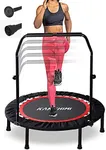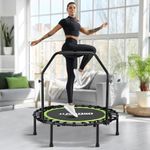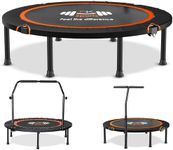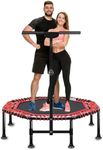Buying Guide for the Best Rebounder Trampolines
Choosing the right rebounder trampoline can be a fun and rewarding experience. Rebounder trampolines, also known as mini trampolines, are great for low-impact exercise, improving balance, and enhancing cardiovascular health. When selecting a rebounder trampoline, it's important to consider several key specifications to ensure you get the best fit for your needs. Here are the main factors to consider and how to navigate them.SizeThe size of a rebounder trampoline is crucial as it determines the amount of space you have for bouncing and the overall footprint of the trampoline. Sizes typically range from 36 inches to 50 inches in diameter. Smaller sizes are more portable and easier to store, making them ideal for limited spaces or for those who plan to move the trampoline frequently. Larger sizes provide more room for movement and can be more comfortable for taller individuals or those who want to perform a wider range of exercises. Consider your available space and how you plan to use the trampoline when choosing the size.
Weight CapacityWeight capacity refers to the maximum weight the trampoline can safely support. This is important for ensuring safety and durability. Rebounder trampolines typically have weight capacities ranging from 200 to 400 pounds. If you are on the heavier side or plan to use the trampoline for vigorous workouts, opt for a higher weight capacity to ensure stability and longevity. Always check the manufacturer's specifications to ensure the trampoline can accommodate your weight.
Spring TypeRebounder trampolines use either metal springs or bungee cords to provide bounce. Metal springs offer a firmer, more responsive bounce and are generally more durable, making them suitable for high-intensity workouts. Bungee cords provide a softer, quieter bounce and are gentler on the joints, making them ideal for low-impact exercises and rehabilitation. Consider your workout intensity and joint health when choosing between spring types.
Frame MaterialThe frame material affects the trampoline's durability and stability. Most rebounder trampolines have frames made of steel or aluminum. Steel frames are strong and durable, providing excellent stability, but they can be heavier and prone to rust if not properly maintained. Aluminum frames are lighter and resistant to rust, making them easier to move and maintain, but they may not be as sturdy as steel. Choose a frame material based on your need for portability and durability.
Mat QualityThe quality of the mat is important for comfort and longevity. Look for mats made from high-quality, UV-resistant materials that can withstand regular use without stretching or tearing. A good mat will provide a consistent bounce and be comfortable to land on. Consider how often you plan to use the trampoline and the types of exercises you will perform to determine the importance of mat quality.
Stability FeaturesStability features such as non-slip feet, adjustable legs, and stability bars can enhance safety and performance. Non-slip feet prevent the trampoline from moving during use, adjustable legs allow you to level the trampoline on uneven surfaces, and stability bars provide extra support for balance and more complex exercises. If you are new to rebounding or plan to perform high-intensity workouts, look for trampolines with these additional stability features.














![DARCHEN 200KG Rebounder Mini Trampoline for Adult, Indoor Small Trampoline for Exercise Workout Fitness, Upgrade Design Springs Trampoline for Safer Quieter Bounce [100 CM]](https://images-proxy.bestreviews.guide/E9Keso2TXh5Cm1WKQbfU9bMDCUA=/0x150/https://m.media-amazon.com/images/I/31RgxrzvLwL._AC_CX679_.jpg)




